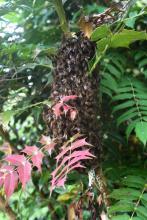Drift
My out-apiary is windy. It's up on a building and almost unshielded from the wind. The consequence is that returning bees get blown around when trying to land. The wind blows from the side, causing bees from Hives C and D to be blown across the fronts of their neighbours. I suppose that this increases the possibility of drift. I haven't seen it happening.
It's almost comical when I sit downwind of the 3 hives. I periodically get covered in a cloud of bees.
- Read more about Drift
- Log in or register to post comments
